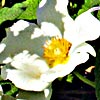Cistus salviifolius (Sage-Leaved Rock Rose) is a low shrub, which reaches a height of a meter. It is branched, evergreen. The leaves are opposite, ovate, wrinkled, coarse to the touch. The bases of the petioles of the two opposite leaves are rolled downwards. The leaves are somewhat lighter in color than those of Cistus creticus (Soft-Hairy Rock Rose), and are somewhat yellowish.
Sage-Leaved Rock Rose blooms from March to May. The flower is large, spread out, with a diameter of up to 6 cm, and the shrub abounds with numerous flowers. Each flower has 5 white petals, 3 broad inner sepals and 2 narrow external sepals. The flower has no nectar, but emits some fragrance. The stamens are yellow, numerous, rich in pollen, and serve pollen-seeking insects. They give the flower a two-tone look, white with yellow center. Each flower lives for one day. It opens early in the morning, and on warm days the petals fall already at noon.
The fruit is glabrous. The species often grows intertwined with Soft-Hairy Rock Rose, but sometimes in almost pure patches, apparently in more humid places, because Soft-Hairy Rock Rose can cope with less humidity. The fruit remains on the plant for a long time, and it is thus easy to distinguish between the species when there is no flowering, since the fruits of Soft-Hairy Rock Rose are hairy.
Sage-Leaved Rock Rose grows, and often even dominates, the batha and the garigue on light Rendzina soil, which develops on marl and chalky rocks in the Mediterranean mountains of Israel. This is unfertile soil, and the Rock Rose perhaps overcomes this shortcomings by symbiosis with Mycorrhiza. In Maquis it develops to a “shade-form”, with longer branches and large leaves, and the entire shrub is larger. An entire group of plant associations was defined by the Israeli researcher Michael Zohary as “cluster of Rock Rose associations”.
Menahem Zaharoni, a researcher with extensive knowledge in geography and a great educator, tells a legend in order to illustrate the difference between the two species of Rock Rose: The Lord of the Forest invited all the flowers to a party, including of course the two brothers from the Rock Rose family. One of them, who was diligent and meticulous, got up early, shaved, sprayed a delicate perfume on himself, put on an ironed white shirt and came to the party on time. His lazy brother got up at the last minute, did not shave, put on the first shirt he found, wrinkled and worn, and ran to the party. When he saw that all the guests were well dressed, clean and orderly, and only he is disheveled, he blushed in shame. Since then the Soft-Hairy Rock Rose has an unshaven fruit, its petals are pink and wrinkled and it has no fragrance, whereas his brother, Sage-Leaved Rock Rose, is not hairy, its petals are white and ironed and it gives off a delicate fragrance.
The Rock Rose serves as a host for the beautiful parasite Cytinus hypocistis (Rape of Cistus).
The genus includes 20 species, where 2 species grow in Israel. The family includes 200 species in 8 genera. Most are common mainly in the Mediterranean countries.
Written by Mike Livne






